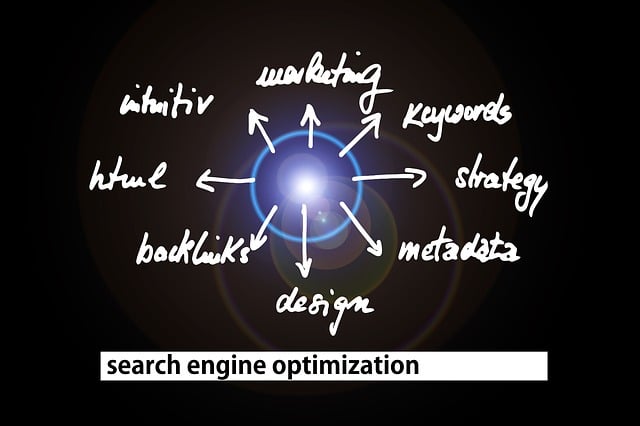TL;DR:
Keyword Research and Optimization (KRO) is essential for maximizing SEO potential by understanding user intent, identifying relevant search terms, and boosting website visibility. This process involves leveraging tools like Google Keyword Planner or SEMrush to uncover high-volume, low-competition keywords, which are then integrated naturally into content. By aligning with audience preferences and trends, KRO enhances site ranking, attracts organic traffic, and improves online presence. It's crucial for on-page optimization (e.g., titles, headings, meta descriptions) and off-page strategies like link building to drive success in today's digital marketing landscape. Regular measurement using tools like Google Search Console helps refine content strategies based on user behavior.
“Unleash your website’s full potential with powerful keyword optimization strategies. In today’s digital landscape, understanding search engine optimization (SEO) is key to visibility. This comprehensive guide takes you on a journey through the intricacies of Keyword Research and Optimization. From identifying target audiences’ hidden desires to mastering on-page elements, we’ll explore effective tools and techniques. Learn how to analyze search volume, outsmart competitors, and craft compelling content that attracts your ideal viewers. Get ready to transform your online presence with these essential SEO practices.”
Understanding Keyword Research: Unlocking SEO Potential

Keyword research is a fundamental step in optimizing your content for search engines, unlocking the full potential of your SEO strategy. It involves understanding user intent and identifying relevant terms that people use to search for information related to your niche. By conducting thorough keyword research, you can discover valuable insights into what your target audience is looking for and how they express their queries. This process helps in tailoring your content to align with these keywords, ensuring it resonates with users’ needs.
Effective keyword optimization leverages tools and techniques to uncover the right terms that have high search volumes but low competition. It involves analyzing various factors such as search trends, user demographics, and competitor strategies. By integrating relevant keywords into your content naturally, you enhance its visibility in search engine results, driving more organic traffic to your website. This strategic approach ensures that your online presence is tailored to the preferences of your target market, ultimately improving your site’s ranking and performance over time.
Identifying Target Audiences and Their Search Behavior

Identifying your target audience is a cornerstone of effective keyword research and optimization for SEO. Understanding who your potential customers are and what they search for allows you to create content that resonates with them. This involves delving into demographics, interests, and pain points to tailor your keywords accordingly. For instance, if your business targets young, tech-savvy professionals, keywords like “latest smartphone trends” or “tech gadgets for productivity” could be relevant.
By analyzing search behavior, you can also uncover popular search terms and phrases used by your audience. Tools like Google Keyword Planner or SEMrush can provide insights into search volumes, competition, and related keywords. This data helps in crafting content that aligns with what your target audience is actively searching for, thereby increasing the chances of ranking higher on search engine results pages (SERPs) and attracting organic traffic.
Tools for Efficient Keyword Discovery

Efficient keyword discovery is a cornerstone of successful SEO, enabling content creators and marketers to understand their audience better. Keyword research tools like Google Ads Keyword Planner, Ahrefs, SEMrush, and Moz Keyword Explorer are indispensable assets. These tools not only provide insights into search volume and competition but also suggest related keywords, helping to uncover a broader range of relevant terms. By leveraging these platforms, businesses can identify high-value keywords that align with their content strategy and target audience, ultimately enhancing the visibility and reach of their online presence.
Effective keyword discovery goes beyond simple tools; it involves an in-depth analysis of industry trends, customer behavior, and competitor strategies. Examining popular search queries, identifying long-tail keywords, and understanding user intent are crucial steps in the process. This holistic approach ensures that the chosen keywords are not only relevant but also highly targeted, driving organic traffic to the website and boosting its SEO performance over time.
Analyzing Search Volume and Competitor Analysis

Optimizing On-Page Elements with Keywords

In the realm of SEO, optimizing on-page elements is a strategic art that involves integrating carefully selected keywords seamlessly into your website’s content. It begins with robust keyword research, where tools and techniques are employed to identify relevant, high-volume search terms. These keywords become the cornerstone of your on-page strategy, guiding the optimization process for various components.
Through this approach, each page’s title, headings, meta descriptions, and body text are meticulously crafted to include the targeted keywords naturally. Such an organic integration signals search engines about the page’s relevance, enhancing its visibility in search results. This strategy is not merely about stuffing keywords but rather creating a compelling user experience while ensuring your content aligns with what users truly seek.
Incorporating Keywords in Content Strategically

Incorporating keywords strategically is a cornerstone of effective content optimization, driven by thorough keyword research and optimization practices. It involves weaving relevant terms seamlessly into your writing, ensuring they appear in both the initial sentences and throughout the piece. This natural integration avoids the clumsiness of overstuffing and maintains readability, which search engines prize. For instance, when crafting an article about “travel tips,” include variations like “travel guide,” “vacation essentials,” or “itinerary planning” to capture a broader audience.
This strategic approach goes beyond mere word placement. It entails understanding the intent behind user searches and aligning your content accordingly. By researching keyword trends, you can identify terms with high search volume but low competition, enhancing your page’s visibility. Moreover, optimizing meta tags, headings, and image alt text with these keywords bolsters your site’s SEO, making it more discoverable to potential readers and search engines alike.
Off-Page Optimization and Link Building for Keyword Boost

Off-page optimization is a crucial aspect of SEO, focusing on activities outside your website to enhance its authority and visibility. One of the most powerful tools in this strategy is link building. Acquiring high-quality backlinks from reputable sources significantly boosts your keyword rankings. When conducting keyword research, identify relevant keywords with solid search volume and low competition; these are ideal targets for link acquisition.
Building links involves reaching out to webmasters or content creators in your niche and securing placements for guest blogging, featured articles, or product mentions. These backlinks act as votes of confidence from other sites, signaling to search engines that your content is valuable and trustworthy. As a result, search engines like Google may reward your website with higher positions in the search results for targeted keywords, driving organic traffic and improving overall SEO performance.
Measuring Success: Tracking Keyword Rankings and SEO Performance

Measuring success in keyword optimization is a crucial aspect of SEO strategy. It involves tracking keyword rankings, which provide insights into the visibility of your website on search engines. By utilizing tools like Google Search Console and analytics software, marketers can monitor where their target keywords stand in search results over time. This data allows them to identify improvements and areas that need attention, ensuring the content remains relevant and competitive.
Regularly evaluating SEO performance is key to staying ahead in the digital landscape. Analyzing keyword rankings helps understand user search behavior and adjust content strategies accordingly. It enables marketers to optimize for both short-term gains and long-term sustainability, making their online presence more effective and engaging.
